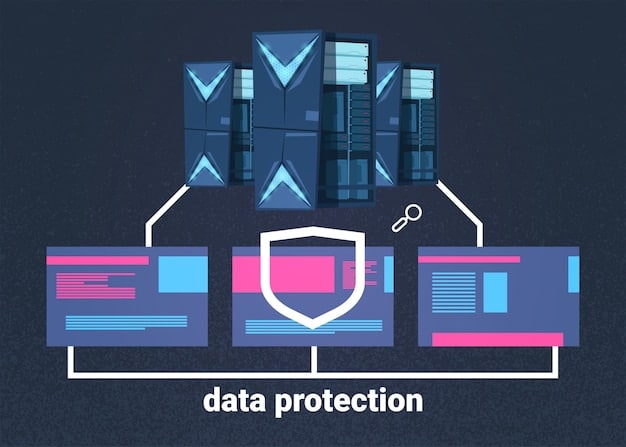Database Security: A Comprehensive Guide to Protecting Your Data

Database security is the practice of implementing various measures to protect sensitive data stored in databases from unauthorized access, theft, or damage, ensuring confidentiality, integrity, and availability.
In today’s digital landscape, databases are the backbone of countless organizations, storing vast amounts of sensitive information. Protecting these databases from unauthorized access is crucial, and this cybersecurity guide: database security: protecting sensitive data from unauthorized access will walk you through the key strategies and best practices.
Understanding the Importance of Database Security
Databases hold a treasure trove of information, from customer data and financial records to intellectual property and trade secrets. A breach can lead to devastating consequences, including financial losses, reputational damage, legal liabilities, and regulatory penalties.
Therefore, understanding the importance of database security is paramount. Organizations must recognize the potential risks and take proactive steps to safeguard their valuable data from both internal and external threats. This involves implementing a multi-layered security approach encompassing technical, administrative, and physical controls.
Common Database Security Threats
One of the most important aspects of database security is understanding the threats against the databases and learning how to mitigate against these. Here are just a few threats to consider when securing your databases:
- SQL Injection: Attackers inject malicious SQL code into input fields to manipulate database queries and gain unauthorized access.
- Brute-Force Attacks: Attackers use automated tools to try numerous username and password combinations to crack authentication.
- Privilege Escalation: Attackers exploit vulnerabilities to gain higher-level privileges and access sensitive data.
- Data Theft: Attackers steal sensitive data through unauthorized access, malware, or insider threats.
By understanding the diverse range of threats, organizations can better defend their databases against malicious activities and protect their valuable data assets. In summary, the stakes are high, and the consequences of neglecting database security can be catastrophic.

Implementing Strong Access Controls
Access controls are the cornerstone of database security, ensuring that only authorized users can access specific data. Implementing robust access controls involves a combination of authentication, authorization, and role-based access control (RBAC).
By implementing robust security management best practices in your organization, you can ensure that your databases remain protected from any potentially bad actors. Let’s take a look at some of these:
Authentication
Authentication verifies the identity of users attempting to access the database. Strong authentication measures should be implemented, such as:
- Multi-Factor Authentication (MFA): Requires users to provide multiple forms of identification, such as a password and a one-time code from a mobile app.
- Strong Password Policies: Enforces the use of complex passwords that are difficult to crack.
- Biometric Authentication: Employs biometric data, such as fingerprints or facial recognition, for authentication.
Authorization
Authorization determines what actions authenticated users are permitted to perform within the database. The principle of least privilege should be adopted, granting users only the minimum level of access required to perform their job duties. This can be done using role-base access.
Role-Based Access Control (RBAC)
RBAC simplifies access management by assigning permissions based on roles rather than individual users. This approach makes it easier to manage user permissions, enforce consistent security policies, and minimize the risk of unauthorized access. Ensuring least privilege for the roles is also critical.
In conclusion, implementing strong access controls is paramount for safeguarding databases from unauthorized access. By enforcing strong authentication measures, implementing granular authorization policies, and adopting RBAC, organizations can create a secure environment that protects their valuable data assets.
Encrypting Sensitive Data At Rest and In Transit
Encryption is a critical security measure, especially when storing sensitive data. It transforms data into an unreadable format, rendering it unintelligible to unauthorized parties. Encryption is essential both when data is stored (“at rest”) and when it’s being transmitted (“in transit”).
This step can often be overlooked, especially when dealing with legacy applications or when the organization lacks experience in database security. It is, however, one of the most important aspects of database security and should not be skipped.
Data Encryption at Rest
Encrypting data at rest protects it from unauthorized access in case of physical theft or unauthorized access to the database server or storage devices. Here are some common methods:
Transparent Data Encryption (TDE): TDE encrypts the entire database, including data files, log files, and backup files. This ensures that the data is protected at the storage level.
- Column-level Encryption: Encrypts specific columns containing sensitive data, offering more granular control over encryption.
- File System Encryption: Encrypts the file system where the database is stored, providing an additional layer of protection.
Data Encryption in Transit
Encrypting data in transit protects it from eavesdropping and interception during transmission over a network. Secure protocols like HTTPS and TLS/SSL should be used to encrypt data transmitted between clients and the database server.
- Virtual Private Networks (VPNs): Encrypt all traffic between the client and server.
- Secure Shell (SSH): A secure protocol used to communicate between the client and server.
- TLS/SSL Certificates: Configuring a valid certificate to secure TCP connections to the database.
By encrypting data both at rest and in transit, organizations can significantly reduce the risk of data breaches and protect their valuable information from unauthorized access. Encryption is a fundamental security control that should be implemented across all critical databases and systems.
Regularly Patching and Updating Database Software
Database software, like any other software, is susceptible to vulnerabilities. Regularly patching and updating database software is crucial to address these vulnerabilities and protect against exploitation. Keeping your database updated should be priority.
Neglecting to apply security patches can leave the database vulnerable to known exploits, allowing attackers to gain unauthorized access, execute malicious code, or cause denial-of-service conditions.

Patch Management Process
Establishing a formal patch management process is essential for ensuring timely and effective patching of database software. This process should include the following steps:
- Vulnerability Scanning: Regularly scan for known vulnerabilities in the database software.
- Patch Assessment: Evaluate the impact and risk associated with each patch before deployment.
- Testing: Test patches in a non-production environment to ensure compatibility and stability.
- Deployment: Deploy patches to the production environment in a timely manner.
Automated Patching Tools
Automated patching tools can streamline the patch management process by automatically downloading, testing, and deploying patches. These tools can significantly reduce the time and effort required to keep database software up to date.
- Database Management Systems (DBMS) Tools: Many DBMS vendors offer built-in tools for managing patches and updates.
- Third-Party Patch Management Solutions: Several third-party vendors offer comprehensive patch management solutions for databases.
In short, regularly patching and updating database software is a critical aspect of database security. By staying on top of security updates and establishing a formal patch management process, organizations can minimize the risk of exploitation and protect their valuable data assets.
Monitoring and Auditing Database Activity
Monitoring and auditing are essential security practices for detecting and responding to suspicious activity. By monitoring database activity and auditing access logs, organizations can identify potential security breaches, detect insider threats, and track compliance with security policies.
A robust monitoring and auditing solution can provide real-time visibility into database operations, enabling security teams to quickly identify and respond to security incidents and ensure the ongoing security of sensitive data.
Database Activity Monitoring (DAM)
DAM solutions monitor database activity in real-time, detecting suspicious behavior such as unauthorized access attempts, SQL injection attacks, and data exfiltration attempts. DAM tools can generate alerts when suspicious activity is detected, enabling security teams to take immediate action to investigate and remediate the issue.
Auditing and Logging
Auditing involves tracking and recording database activity, such as user logins, data access, and schema changes. Audit logs provide a valuable record of database activity, which can be used to investigate security incidents, identify potential vulnerabilities, and demonstrate compliance with regulatory requirements.
- Enable Audit Logging: Enable audit logging for all critical database activities.
- Secure Audit Logs: Secure audit logs from tampering and unauthorized access.
- Analyze Audit Logs: Regularly review and analyze audit logs to identify suspicious activity.
Essentially, monitoring and auditing database activity is essential for maintaining a strong security posture. By implementing DAM solutions and establishing robust auditing practices, organizations can proactively detect and respond to security threats and ensure the ongoing protection of their valuable data assets.
Regularly Backing Up and Restoring Databases
Backups are crucial for recovery in case of a data loss event. Regularly backing up databases enables organizations to recover data in case of hardware failures, software errors, natural disasters, or cyberattacks.
Without proper backups, organizations risk losing critical data, which can lead to business disruption, financial losses, and reputational damage. Thus, implementing a robust security plan and having an exact copy of your data is crititcal.
Backup Strategies
There are several backup strategies that can be used, depending on the specific requirements and resources of the organization. Here are some common backup strategies:
- Full Backups: Back up the entire database.
- Incremental Backups: Back up only the changes made since the last full or incremental backup.
- Differential Backups: Back up only the changes made since the last full backup.
- Cloud Backups: Storage of backups in cloud services with geo-replication and redundancy.
One must determine their RPO (Recovery Point Objective) and RTO (Recovery Time Objective) in order to chose the ideal backup strategy for them.
Testing and Verification
The importance of testing backups cannot be overstated. Testing backups ensures that they are valid and can be successfully restored when needed. Regular testing helps identify potential issues with the backup process, such as corrupted backups, compatibility issues, or inadequate storage capacity.
- Test Restores: Regularly test restoring backups to a test environment.
- Verify Data Integrity: Verify the integrity of the restored data to ensure that it is accurate and complete.
In conclusion, regularly backing up and testing databases is essential for protecting data from loss and ensuring business continuity. Organizations should implement a robust backup strategy, automate the backup process, and regularly test backups to ensure that they can be successfully restored when needed.
| Key Aspect | Brief Description |
|---|---|
| 🔑 Access Controls | Enforce authentication and authorization policies to restrict database access to authorized users only. |
| 🔒 Encryption | Protect sensitive data using encryption techniques, both at rest and in transit, to prevent unauthorized access. |
| 🛡️ Patching | Keep your database software up to date by regularly applying security patches to address known vulnerabilities. |
| 🕵️ Monitoring | Implement monitoring and auditing mechanisms to track database activity and detect suspicious behavior. |
Frequently Asked Questions
▼
Database security involves implementing measures to protect databases from threats like unauthorized access, data breaches, and data loss. It ensures data confidentiality, integrity, and availability.
▼
Database security is crucial because databases often contain sensitive information. Breaches can lead to financial losses, reputational damage, legal issues, and compliance violations for the organization.
▼
Common threats include SQL injection, brute-force attacks, privilege escalation, malware, phishing, insider threats, and DDoS attacks targeting database resources leading to potential data theft and breaches.
▼
To enhance database security implement strong access controls, use encryption, regularly patch software, monitor database activity, and back up data frequently. Conduct security audits and training.
▼
RBAC assigns access based on roles rather than individual users, simplifying management and ensuring users only have the necessary permissions. This minimizes unauthorized access risks in critical data management.
Conclusion
Protecting databases from unauthorized access is an ongoing process that requires a multi-faceted approach. By implementing the strategies and best practices outlined in this guide, organizations can significantly reduce the risk of data breaches and protect their valuable data assets.





